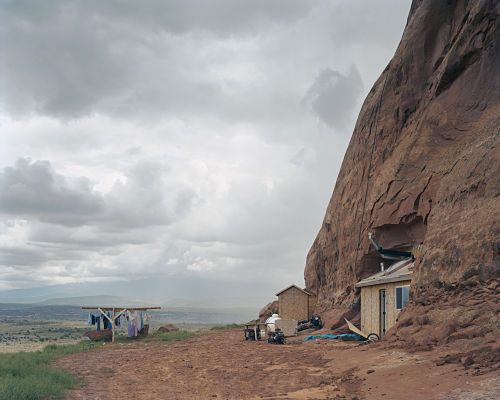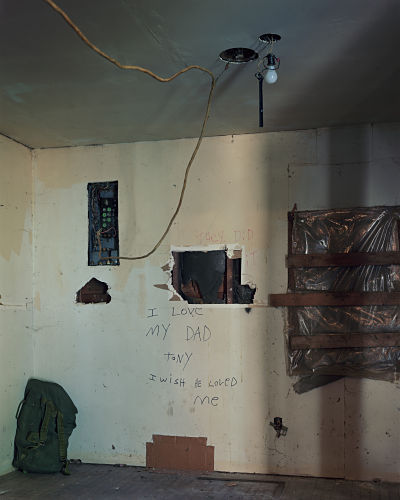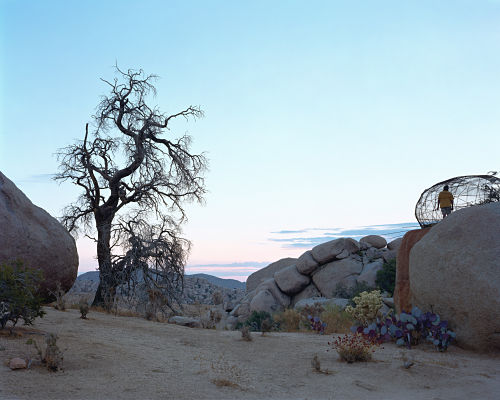Alec Soth's, Broken Manual--at Sean Kelly Gallery until March 11 -- examines America's dream of escape and the individuals who have taken the plunge.
These are portraits of men with beards, and houses built in caves, of barricades, and hand-made weapons. The images suggest anger, paranoia, and discontent, and yet the narrative is powerfully interrupted by nature. Makeshift dwellings are built in seductive landscapes -- in dense forest or open desert -- alternately inhospitable and utopic, desperate and daring.

ALEC SOTH, "Utah", 2008 © Alec Soth
Taken from 2006-10, as Soth drove cross-country with a large format camera, the photographs themselves are a kind of escape -- a wager with the unknown that few artists dare to make. An accompanying documentary, Somewhere to Disappear, by Laure Flammarion and Arnaud Uyttenhove, shows Soth steering down unnamed roads at nightfall, and knocking on decrepit doors. One gets the sense that he has learned to read maps backwards -- to go towards emptiness, to turn opposite the signs that lead somewhere. Often he ends up in the middle of nowhere, but then improbably uncovers people who make it their business to hide.
An old man stands by a tomato patch in the woods. Another stands in a wire dome in a desert. A cave, painted white, is furnished with a desk, a bed, a clothing-rod. The scenarios are antisocial, and yet their extreme self-reliance is tinged by the mystical, the meditative. For better or worse, the subjects are people who have carried through on the desire to escape, and Soth makes the impulse feel familiar, even as he reveals the failure, or misguidedness of these attempts.

ALEC SOTH, "2007_10zl0006" © Alec Soth
If there is something lonely and frightening in these images, there is also something dream-like and remembered -- something fed by our own fantasies -- the desire for freedom and safety, the desire to provide for oneself. We recognize the form -- the lure of uncharted territory, the mythos of the log cabin. They recall hideaways that take shape in childhood -- the forts built at the back of a closet, the tree-houses at the edge of the yard. We suspect they exist, and yet we're still surprised to see them revealed.
These photographs feel intensely private. In some we are aware of the subjects' reluctance to be seen. Others, like one of a desperate message scrawled on a wall, make us more aware of our own reluctance to look. Still, they don't seem voyeuristic. Clearly something intimate has transpired between Soth and his subjects. We are reminded that photography is not a neutral medium -- not because of special effects, or the omissions of framing -- but because we feel that only someone who related to the same desires could be granted access.

ALEC SOTH, "2008_08zl0031" © Alec Soth
Even when devoid of people, objects and landscapes look different in the context of the show. The image of a forest is marked by melancholy -- neither frontier-like nor pastoral -- not a place to explore, but one in which to disappear, the habitat of other hidden people. In another a light bulb hanging over a blanket in the woods might seem like a conceptual joke, if we weren't so aware of the circumstances that created it.
In the documentary, Soth says his project is, "not about running away, but about the dream of running away." His talent, he explains, "lies in transforming these ideas into some sort of path through the world." This is art then, not just as record, or expression, but as a tool for inquiry, a framework for discovery. In the way a geologist reads a landscape to determine where best to mine a mineral, Soth taps into veins of thought and fantasy. He seeks out the habitats of fear and pain and paranoia, and conjures men from woods and deserts, the way others dowse for water. Yet these encounters are marked by immense gentleness and empathy. There is even some comfort in the thought of being found in the depths of retreat by Alec Soth -- of being found by someone likeminded, by someone looking.
All images courtesy: Sean Kelly Gallery, New York